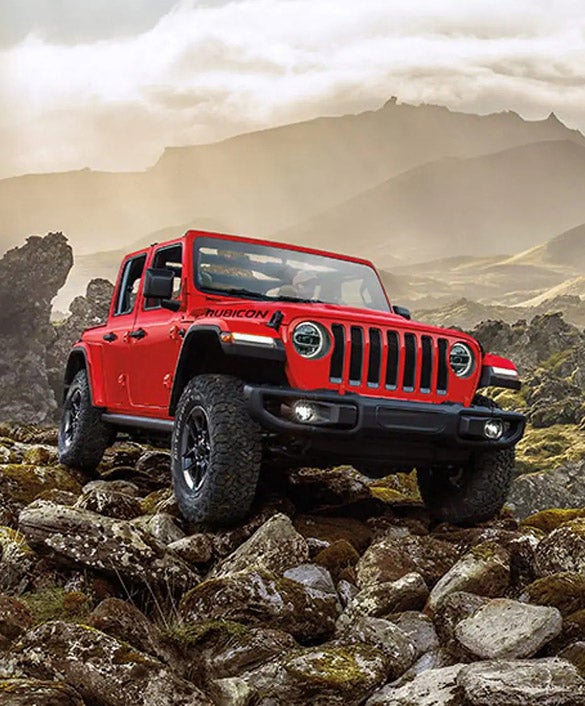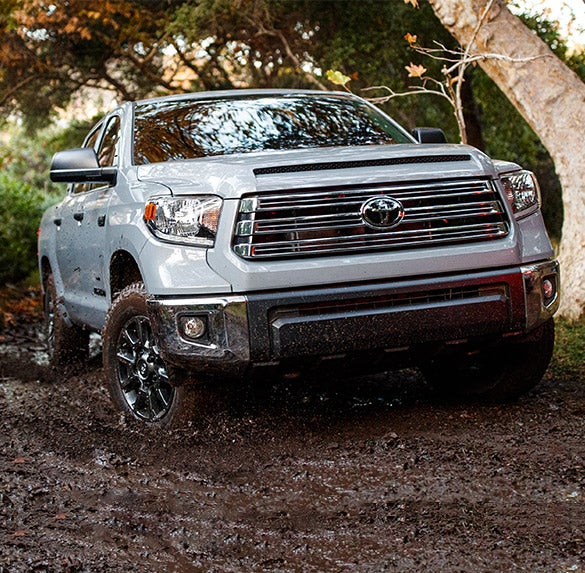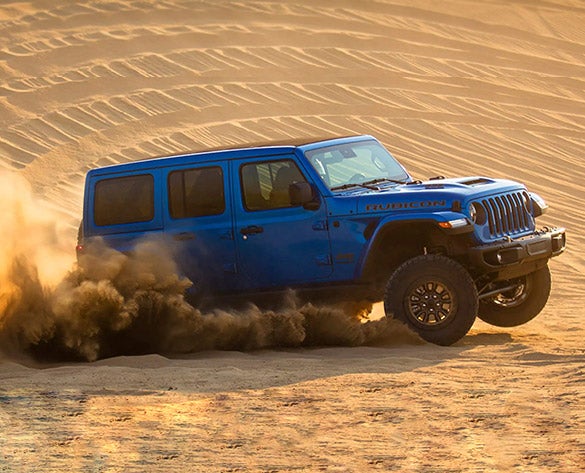4WD High Vs. Low: When To Use 4 Wheel Drive 4H Vs. 4L

4WD high vs. low. What's the difference? How to use it? When to use it? Is this system better than FWD, RWD, or 2WD? Holy smokes! Things can get confusing. On this page, your friends at Autoflex are going to reveal the answers to these questions so you can get out there, have fun, and use your vehicle to its full potential. In general, any discussion about 4WD or AWD comes down to traction (how well your wheels grip the driving surface so you can continue moving). The benefits of 4WD were proven in a big way on the battlefields of WWII. The 4WD Willys Jeep, the great grandfather of today's Jeep Wrangler, took troops and equipment virtually anywhere (and vehicle manufacturers took notice). Since that time, 4WD has become a mainstay in many vehicles. These systems are used to enhance all-weather safety and access the great outdoors. Continue reading to understand how the system works, how it evolved, and the subtle differences between system variants so you can choose the right vehicle for your next adventure.
4WD High vs. Low. How It Works & What To Know
Let's start at the beginning. Your vehicle gets power from the engine (which spins internally). The spinning turns a rotational device called a crankshaft, which is connected to a flywheel (at the rear of the engine). The back of your engine is connected to the transmission either by a clutch or torque converter (depending on whether you have a manual or automatic transmission). Transmissions spin internally and rotate something called an output shaft. The output shaft is connected to the rear axle, front axle, or both (and these axles are known technically as final drives). Now here's the key:
- If your transmission faces the back of the vehicle - and connects to the rear wheels only, you have RWD or 2WD, as only those wheels receive power (like a base GMC Sierra 1500).
- If your transmission faces the back of the vehicle - and connects to the rear wheels and front wheels via a transfer case (known as a center differential), you have a 4WD system of some type (either full-time or part-time). As all four wheels mechanically receive engine power.
- If your transmission is located under your engine facing sideways (a transverse transmission) - and connects to the front wheels, you have FWD since only the front wheels mechanically receive engine power.
- If you have a 2-Speed transfer case - then you have a 4WD high vs. low set-up.
Nowadays, RWD or 2WD drivetrains are reserved exclusively for sports cars, mostly for weight distribution purposes. However, most manufacturers of passenger vehicles will offer FWD with their vehicles because time has proven it to have superior traction over RWD cars. You can thank Land Rover for having perfected the 4WD system, which now includes electronic controls such as Terrain Response (snow, rain, mud, sand, and gravel modes). Land Rover introduced this system in 2003 to the market, and "drive modes" now exist in almost every vehicle.


4 High vs. 4 Low: Explained
Think of 4lo vs. 4hi as the difference between gears on a 10-speed mountain bike. If you're climbing a hill, you'll select first gear (or low gear) to make it easier on your legs. Even though speed is limited in lower gears, your ability to remain in control is intact. On the other hand, when conditions are not extreme and you need higher speeds, you'll find your way to 10th gear (or high gear) to achieve easier cruising speeds. Without jumping into the history of simple machines and mechanical engineering, just know that gears (just like the ones on a mountain bike or in your Toyota Tundra) are a mechanical device that optimizes how your vehicle can make the most of your engine's power by providing forward movement under a variety of conditions.
- So when to use 4WD high? If you are moving at speeds greater than 25mph and need superior traction, then 4WD high will be the way to go — such as cruising to the ski slopes on the interstate when the first snowflakes begin to fall.
- When to use 4 Low? When speed doesn't matter, but brute-force does, then you'll want 4 low. Some common instances for using 4 low are towing heavy objects, extreme vertical climbs, rock crawls, or water crossings.
The primary difference between 4h and 4L comes down to speed. In both cases, all four wheels are receiving power from the engine via the transfer case, but the gearing selected within the transfer case (high or low, just like with our mountain bike) determines your top speed and capabilities. Most vehicles require shifting into neutral prior to shifting into 4WD Low, like with the 4x4 Jeep Renegade. Newer vehicles like this will have a button to push for 4L instead of the old days when you would do it yourself with a heavy-duty mechanical lever in the vehicle.
But Wait, There's More!
We've talked about 4WD, how the system works, and the differences between 4x4 high vs. low. But what about the differences between 4x4 and AWD? Are they the same? Different? A lot of places will tell you they are the same. THEY ARE NOT. Yes, they both aim to provide the driver traction in slippery conditions, but they are not the same system at all. Here are the differences to understand when selecting a vehicle that's right for you:
- 4x4 is purely mechanical. The transmission connects to a transfer case that sends power to the rear wheels (so they can push you) and to the front wheels (so they can pull you). The advantage of this system is that you are in control.
- AWD is electronic. AWD systems favor either the front or rear wheels of the vehicle, and when the vehicle detects traction loss via sensors, the AWD system engages the other axle to mimic 4WD. When conditions permit, your AWD system "lets go" of the engaged axle, and you're back to FWD or 2WD. The major benefit here is fuel efficiency. AWD vehicles are considerably more efficient than 4WDs. The downside of AWD is long-term reliability. When all those traction sensors give up, so does your AWD system.
So if you want to confidently go over the river and through the woods, Grandmas everywhere prefer the mechanical strength of 4WD.

Beyond 4WD: Gear States, Drive Modes, Computers & More
Take a look at the transfer case lever inside your older Toyota Tacoma. See that curious "2H 4H 4L" stamp on the little shift knob? Even in newer versions, this gear range selector indicates you have a part-time 4x4 system. In a sense, the system is comparable to AWD, but you determine when 4WD is needed. In almost all cases, you can shift from 2H to 4H on the fly at any speed. The only exception is getting to 4L. You will need to stop completely and find neutral before switching to 4L. Some vehicles require you to reverse for several feet after taking 4L, while others require you to coast in neutral at about 5mph to find 4L. Consult your owner's manual for exact instructions.
Now, let's step into the 21st century. Most of us have seen vehicles with buttons or dials that allow us to select weather or driving conditions. What is that all for, exactly? Let's take a look at the all-new RAM 1500 TRX. This 700hp+ monster has full-time 4WD and nine specialized drive modes. There are specialized modes for snow, mud, rocks, sand, sport, comfort, customized modes, and more. So what happens when you select any of those options?
Drive modes allow you to further maximize traction and dynamics at the push of the button. It is a huge convenience feature for any driver. There's no need to be a skilled off-road racer to know how to make it through a canyon. Virtually anyone can get in, push a button for the right condition, and your vehicle "knows what to do." All you have to do is drive. The vehicle handles the rest. In all circumstances, these modes use electronic systems in your vehicle to manage and enhance wheel spin, engine load, suspension damping, transmission logic, and even steering. All of that capability is achieved by sophisticated computers that work together in your vehicle to make driving in any condition much safer.
Autoflex. The Name You Know for Capability
Here at Autoflex, we have a go-anywhere attitude towards leasing and purchasing. You might just consider us the 4WD or AWD of the car leasing world because nothing stops us from helping you get in the driver's seat. Year after year, we've been putting together award-winning programs that help our customers get into the vehicle of their dreams while other dealerships stood in their way, like Mt. Everest in front of a 2WD go-kart. You won't need a 4WD to come find us in Dallas, TX. Our signs are everywhere. Thanks for taking a few minutes to read our 4H vs. 4L page. We hope that it was helpful to you, and we look forward to seeing you down here soon!

